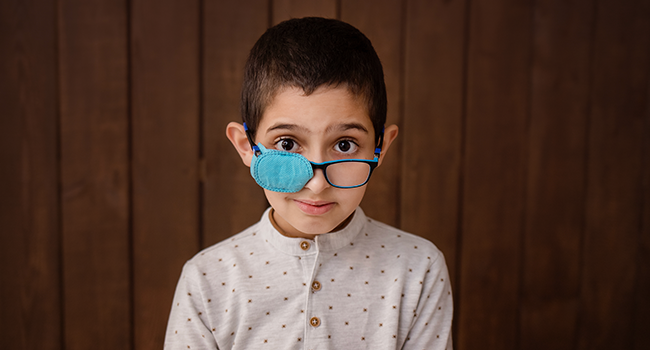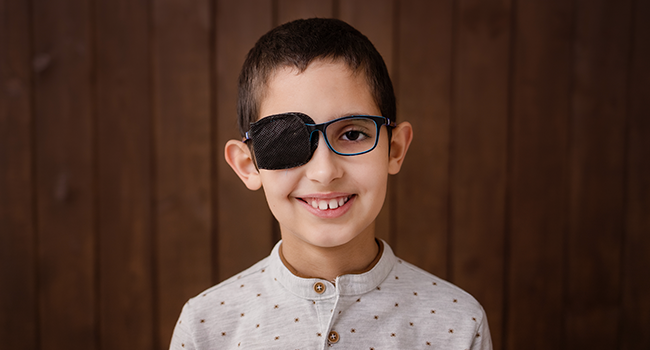
Lazy eye, also known as amblyopia, is a vision disorder that occurs in childhood. It is characterized by reduced vision in one eye that cannot be fully corrected with glasses or contact lenses. This condition typically develops during early childhood and affects approximately 2-3% of children.
In lazy eyes, the brain and the eye do not work together properly, leading to reduced vision in the affected eye. If left untreated, a lazy eye can result in permanent vision loss. However, with early diagnosis and appropriate lazy eye treatment, the vision in the affected eye can be improved.
This article will provide an overview of the symptoms, causes, and lazy eye treatment options, helping you better understand this condition and its management.
Understanding Lazy Eye (Amblyopia)
Lazy eye, or amblyopia, is a condition that affects the visual development in children. It occurs when the brain favors one eye over the other, resulting in reduced vision in the weaker eye. The brain relies more on the stronger eye, causing the visual pathway of the weaker eye to remain underdeveloped.
Lazy eyes can be caused by various factors, such as strabismus (crossed or misaligned eyes), significant differences in refractive errors between the two eyes, or visual deprivation, which occurs when there is a blockage or cloudiness in the eye that prevents clear vision.
It is important to detect and treat lazy eye early in order to prevent permanent vision loss and promote normal visual development in children. Regular eye exams are crucial for identifying lazy eye and other vision problems.
What Is Lazy Eye (Amblyopia)?
Lazy eye, also known as amblyopia, is a condition that affects the visual acuity in one or both eyes. It occurs when the brain and the eye do not work together properly, leading to reduced vision in the affected eye.
Lazy eye can develop due to various reasons, including the presence of strabismus (misaligned eyes), significant differences in refractive errors between the two eyes, or visual deprivation caused by a blockage or cloudiness in the eye. These factors disrupt the normal visual development process, leading to poor vision in the affected eye.
Lazy eye is most commonly diagnosed in childhood, usually before the age of 7. If left untreated, it can result in permanent vision loss in the affected eye. However, with early detection and appropriate lazy eye treatment, the vision in the lazy eye can be improved.
Exploring Causes of Lazy Eye
Lazy eye, or amblyopia, can be caused by various factors. The most common causes include:
Strabismus: Misalignment of the eyes, either inward or outward.
Refractive errors: Significant differences in the prescription of the two eyes, such as nearsightedness, farsightedness, or astigmatism.
Visual deprivation: Blockage or cloudiness in the eye that prevents clear vision, such as cataracts or droopy eyelids.
These factors disrupt the normal visual development process, leading to poor vision in the affected eye. It is important to identify and address these causes early to prevent permanent vision loss.
Recognizing Symptoms of Lazy Eye
Lazy eye, also known as amblyopia, can be recognized by the following symptoms:
- Reduced vision in one eye
- Eyes that do not appear to work together
- Poor depth perception
- Squinting or shutting one eye
- Tilting or turning the head to see objects
- Headaches or eye strain
If you notice any of these symptoms in yourself or your child, it is important to consult an eye care professional for a comprehensive eye examination.
Complications & Risks of Lazy Eye
Lazy eye, or amblyopia, can lead to several complications and risks if left untreated. These include:
- Permanent vision loss in the affected eye
- Reduced depth perception
- Strabismus (misaligned eyes)
- Impaired visual function in adulthood
Early diagnosis and lazy eye treatment can help prevent these complications and improve the vision in the affected eye.
Diagnosis Of Lazy Eye (Amblyopia)
Lazy eye, or amblyopia, can be diagnosed through a comprehensive eye examination. The eye care professional will assess the visual acuity of each eye, check for any misalignment or refractive errors, and evaluate the overall eye health.
Additional tests, such as a visual field test or a retinal examination, may also be conducted to determine the extent of the vision loss and identify any underlying causes.
Early diagnosis is crucial for effective lazy eye treatment. It is recommended to have regular eye exams, especially for young children, to detect and address any vision problems at an early stage.
Treatment Options for Lazy Eye
Lazy eye, or amblyopia, can be treated through various methods depending on the severity of the condition and the underlying causes. The most common lazy eye treatment options include:
Patching: Covering the stronger eye with an adhesive patch to force the brain to use and develop the weaker eye.
Atropine eye drops: Dilating the pupil of the stronger eye to blur the vision and encourage the brain to rely on the weaker eye.
Vision therapy: Special exercises and activities designed to improve the visual function and coordination of the eyes.
In some cases, glasses or contact lenses may also be prescribed to correct any refractive errors and improve vision in the affected eye. The lazy eye treatment plan will be tailored to each individual based on their specific needs and condition.
Prevention and Management of Lazy Eye
Preventing and managing lazy eye, or amblyopia, involves early detection and lazy eye treatment. It is important to schedule regular eye exams, especially for young children, to identify any vision problems at an early stage.
If a lazy eye is detected, early intervention is crucial to prevent permanent vision loss. Treatment options such as patching, atropine eye drops, vision therapy, and lazy eye surgery can help improve the vision in the affected eye and promote normal visual development.
Additionally, addressing any underlying causes, such as strabismus or refractive errors, is important to prevent the recurrence of lazy eye.
By being proactive in monitoring and managing eye health, lazy eye can be effectively treated, and the vision in the affected eye can be improved.
Conclusion
Lazy eye, or amblyopia, is a vision disorder that occurs in childhood and is characterized by reduced vision in one eye. It is important to detect and treat lazy eye early to prevent permanent vision loss.
This blog has provided an overview of the symptoms, causes, and lazy eye treatment options. Regular eye exams and early intervention play a crucial role in managing this condition and promoting normal visual development in children. If you suspect a lazy eye in yourself or your child, consult an eye care professional for a comprehensive eye examination and appropriate treatment.
Remember, early detection and lazy eye treatment can make a significant difference in improving the vision and overall quality of life for individuals.
FAQs
What causes a lazy eye?
In lazy eyes, the brain and the eye do not work together properly, leading to reduced vision in the affected eye. The brain relies more on the stronger eye, causing the visual pathway of the weaker eye to remain underdeveloped.
Can lazy eye be corrected?
Lazy eye, or amblyopia, can be treated through various methods depending on the severity of the condition and the underlying causes. The common amblyopia treatments are patching, atropine eye drops, vision therapy, or lazy eye surgery.
Is lazy eye common?
Lazy eye, or amblyopia, is relatively common, affecting around 2-3% of the population of our country.
Can lazy eyes develop in adults?
While a lazy eye typically develops in childhood, it can also occur in adults due to various factors such as strabismus (eye misalignment) or vision problems.
How is lazy eye diagnosed?
Lazy eye is diagnosed through comprehensive eye examinations, including visual acuity tests and assessments of eye alignment and movement.
What treatments are available for lazy eye?
Amblyopia treatments may include wearing an eye patch over the stronger eye to encourage the weaker eye to work harder, vision therapy, and in some cases, corrective eyewear or lazy eye surgery.
At what age is it too late to treat lazy eye?
It’s generally recommended to start amblyopia treatment as early as possible, ideally before the age of 7 or 8, but it’s still possible to see improvement in vision with treatment even in adulthood.

